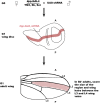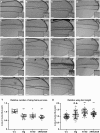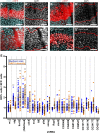An RNAi Screen for Genes Required for Growth of Drosophila Wing Tissue
- PMID: 31387856
- PMCID: PMC6778782
- DOI: 10.1534/g3.119.400581
An RNAi Screen for Genes Required for Growth of Drosophila Wing Tissue
Abstract
Cell division and tissue growth must be coordinated with development. Defects in these processes are the basis for a number of diseases, including developmental malformations and cancer. We have conducted an unbiased RNAi screen for genes that are required for growth in the Drosophila wing, using GAL4-inducible short hairpin RNA (shRNA) fly strains made by the Drosophila RNAi Screening Center. shRNA expression down the center of the larval wing disc using dpp-GAL4, and the central region of the adult wing was then scored for tissue growth and wing hair morphology. Out of 4,753 shRNA crosses that survived to adulthood, 18 had impaired wing growth. FlyBase and the new Alliance of Genome Resources knowledgebases were used to determine the known or predicted functions of these genes and the association of their human orthologs with disease. The function of eight of the genes identified has not been previously defined in Drosophila The genes identified included those with known or predicted functions in cell cycle, chromosome segregation, morphogenesis, metabolism, steroid processing, transcription, and translation. All but one of the genes are similar to those in humans, and many are associated with disease. Knockdown of lin-52, a subunit of the Myb-MuvB transcription factor, or βNACtes6, a gene involved in protein folding and trafficking, resulted in a switch from cell proliferation to an endoreplication growth program through which wing tissue grew by an increase in cell size (hypertrophy). It is anticipated that further analysis of the genes that we have identified will reveal new mechanisms that regulate tissue growth during development.
Keywords: Drosophila; endoreplication; polyploid; tissue growth; wing disc.
Copyright © 2019 Rotelli et al.
Figures



Similar articles
-
Genome-wide phenotypic RNAi screen in the Drosophila wing: global parameters.G3 (Bethesda). 2021 Dec 8;11(12):jkab351. doi: 10.1093/g3journal/jkab351. G3 (Bethesda). 2021. PMID: 34599819 Free PMC article.
-
RNAi screen in the Drosophila wing of genes encoding proteins related to cytoskeleton organization and cell division.Dev Biol. 2023 Jun;498:61-76. doi: 10.1016/j.ydbio.2023.03.010. Epub 2023 Apr 2. Dev Biol. 2023. PMID: 37015290
-
The function of replication and SCF complex during Drosophila wing development.Front Biosci (Landmark Ed). 2018 Jun 1;23(12):2235-2244. doi: 10.2741/4702. Front Biosci (Landmark Ed). 2018. PMID: 29772558
-
Wing tips: The wing disc as a platform for studying Hedgehog signaling.Methods. 2014 Jun 15;68(1):199-206. doi: 10.1016/j.ymeth.2014.02.002. Epub 2014 Feb 17. Methods. 2014. PMID: 24556557 Review.
-
Forces shaping the Drosophila wing.Mech Dev. 2017 Apr;144(Pt A):23-32. doi: 10.1016/j.mod.2016.10.003. Epub 2016 Oct 23. Mech Dev. 2017. PMID: 27784612 Review.
Cited by
-
The transcription factor RUNT-like regulates pupal cuticle development via promoting a pupal cuticle protein transcription.PLoS Genet. 2024 Sep 12;20(9):e1011393. doi: 10.1371/journal.pgen.1011393. eCollection 2024 Sep. PLoS Genet. 2024. PMID: 39264939 Free PMC article.
-
Activation of a Src-JNK pathway in unscheduled endocycling cells of the Drosophila wing disc induces a chronic wounding response.bioRxiv [Preprint]. 2025 Mar 13:2025.03.12.642788. doi: 10.1101/2025.03.12.642788. bioRxiv. 2025. Update in: Genetics. 2025 Jul 31:iyaf147. doi: 10.1093/genetics/iyaf147. PMID: 40161657 Free PMC article. Updated. Preprint.
-
Drosophila pVALIUM10 TRiP RNAi lines cause undesired silencing of Gateway-based transgenes.Life Sci Alliance. 2022 Nov 29;6(2):e202201801. doi: 10.26508/lsa.202201801. Print 2023 Feb. Life Sci Alliance. 2022. PMID: 36446522 Free PMC article.
-
Caenorhabditis elegans SynMuv B gene activity is down-regulated during a viral infection to enhance RNA interference.bioRxiv [Preprint]. 2024 Jul 16:2024.07.12.603258. doi: 10.1101/2024.07.12.603258. bioRxiv. 2024. PMID: 39071373 Free PMC article. Preprint.
-
An unscheduled switch to endocycles induces a reversible senescent arrest that impairs growth of the Drosophila wing disc.bioRxiv [Preprint]. 2024 Mar 14:2024.03.14.585098. doi: 10.1101/2024.03.14.585098. bioRxiv. 2024. Update in: PLoS Genet. 2024 Sep 3;20(9):e1011387. doi: 10.1371/journal.pgen.1011387. PMID: 38559130 Free PMC article. Updated. Preprint.
References
Publication types
MeSH terms
Substances
Grants and funding
LinkOut - more resources
Full Text Sources
Molecular Biology Databases
